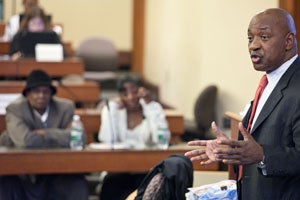The courtroom battle appeared to be a mismatch. An expert defense lawyer cross-examined a career criminal whose modus operandi is robbing drug dealers. “You are a parasite who leeches off the culture of drugs,” the lawyer said, before the witness interrupted him: “Just like you, man. I got the shotgun, you got the briefcase.” In the end, the jury sided with the criminal.
Professor Charles Ogletree ’78 said that the encounter provides an important lesson for lawyers, judges, and law students. Sometimes a jury will favor a criminal witness who tells a compelling story over even the best-educated lawyer.

Cast members Jim True-Frost, Jamie Hector, and Andrew Royo
It’s a lesson that comes not from a law book but from the television series The Wire, a celebrated portrayal of street gangs in inner-city Baltimore and the institutions, from the police to the media to the schools, that have failed its residents. Over five seasons on HBO, the show tackled topics such as the drug war, wiretapping, corruption, and intergenerational incarceration—all topics worthy of examination inside and outside the classroom, according to Ogletree. That is why he established a new class based on the show—“Race and Justice: The Wire”—whose curriculum includes readings and discussions on drug policy, police practices, and legal tactics. He also supplemented the class with a public speaker series featuring cast members and creators of The Wire and community activists involved with the real-life issues raised in the show.
“The Wire contains every digestible aspect of our system—education, jobs, housing, criminal justice system, the role of police in communities—and it’s hard to think about how it doesn’t relate to the basic and critical curriculum that we offer here at the law school,” Ogletree said. “For me, it’s a reenergized way of thinking about the law and to contrast the social science work that we rely upon in The Wire to the traditional doctrinal cases that we examine in law school.”
Click here to view the April 12 public event featuring cast members and the series’ co-creators/writers.
In a class session near the end of the spring semester, students discussed their ideas for a paper reflecting on topics raised in the series. One considered changes that can be made to improve inner-city public housing to combat the type of open-air drug markets depicted in The Wire. Another student proposed legalization of the drug trade while a classmate talked about rebuilding the lives of incarcerated people by offering internship programs and support groups.
Guests frequently appeared in the class, with previous sessions including judges, professors, and former mayors Kurt Schmoke ’76 of Baltimore and Anthony Williams ’87 of Washington, D.C. On this day, former New York Times reporter Fox Butterfield talked about the book he is writing, which looks at crime and families through the lens of one family with 55 of its members in prison. His wife, Elizabeth Mehren, a journalism professor at Boston University, detailed her work covering girls affiliated with gangs, typically to ingratiate themselves with male members. The subject led one student to ask about the Wire character Snoop, a female gang member. The woman who played her, Felicia Pearson, had recently been arrested on drug charges in Baltimore.

Donnie Andrews and cast member Sonja Sohn
Students said they were drawn to the class because of Ogletree and for the chance to examine issues of race and social justice. And of course, many loved watching The Wire. In fact, when Ogletree first referenced The Wire in teaching an introductory criminal law class several years ago, he was surprised at how many students had seen the series and how much they had already learned from it.
One fan who took the class, 3L Lea Downey, said the show provides common ground for people from all backgrounds to talk about the issues depicted. Hoping to work in legal aid after a clerkship, she said public interest work often involves helping people facing challenges like those seen on The Wire. “Learning about what the constituency is going through is never a bad thing,” she said. 3L Kamilah Willingham wanted to take a class that addressed race and found that “I’ve gotten a renewed interest in the issues we’re talking about, not just of black communities but the lower class in America, and also a confidence that these are issues I can address in my career going forward.”
Ogletree wants students to see the series not merely as entertainment but as “a glimpse into the great divide between the haves and the have-nots.” Regardless of what careers students pursue, they can play a role in forging solutions to the problems that plague urban America, he said.

Fran Boyd Andrews and Donnie Andrews
“I’m not trying to turn 150 law students into 150 prosecutors or public defenders,” said Ogletree. “I’m trying to turn them into critical thinkers, problem solvers, and from my point of view social engineers. Whether you’re at a major law firm or a position in government or in a private equity business, you can still do things that make society better.”
He noted that many of the cast members of the show are trying to do just that, with foundations and other efforts to help at-risk youth. In April, several Wire actors appeared in Ames Courtroom along with co-creators David Simon and Ed Burns via video link. Also appearing was Donnie Andrews, the model for the character Omar Little, the witness lambasted by the defense lawyer in the courtroom. Reflecting on his criminal past, which brought him a long stint in prison, Andrews said: “Every day, I lived a life according to my environment, not according to me.”
Sitting near him, Michael Williams, who played Little on the show, said that many people pretend that environment doesn’t exist. Yet The Wire gave voice to problems that shouldn’t be ignored. “It showed mainstream America what’s really going on,” Williams said. “Although it was set in Baltimore, there’s a Wire in every city.”

